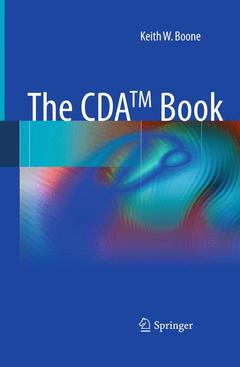The CDA TM book, 2011
Auteur : Boone Keith W.

Section IV: Implementing CDA.- 1. Clinical Documentation.- 1.1 Properties of Clinical Documents.- 1.2 The 6 Characteristics of Clinical Documents.- 2. The HL7 Clinical Document Architecture2.1 History of the Clinical Document Architecture.- 2.2 CDA is based on XML.- 2.3 Structure of a CDA Document.- 2.4 Levels of CDA.- Summary .- 3. Extensible Markup Language.- 3.1 The XML Declaration.- 3.2 Namespaces.- 3.3 XML Schema Language.- 3.4 Parsing the CDA XML.- Summary.- 4 Basic Data Types.- 4.1 ANY.- 4.2 Booleans.- 4.3 Quantities.- Summary.- 5 Text and Multimedia.- 5.1 BIN Binary.- 5.2 ED Encapsulated Data.- 5.3 ST String.- Summary.- 6 Demographic Data.- 6.1 ADXP Address Part.- 6.2 AD Address Mixed Content Models.- 6.3 ENXP Entity Name Part.- 6.4 EN Entity Name.- 6.5 ON Organization Name.- 6.6 PN Person Name.- 6.7 TN Trivial Name.- 6.8 II Instance Identifier.- Stupid Geek Tricks.- 6.9 TEL Telecommunications Address.- Summary.- 7 Codes and Vocabularies.- 7.1 Concepts.- 7.2 Codes.- 7.3 Coding Systems.- 7.4 Pre- and Post-Coordination.- 7.5 Value Sets.- Summary.- 8 Codes.- 8.1 CD Concept Descriptor.- 8.2 CE Coded With Equivalents.- 8.3 CV Coded Value.- 8.4 CO Coded Ordinal.- 8.5 CS Coded Simple.- Summary.- 9 Dates and Times.- 9.1 TS Time Stamp.- 9.2 IVL_TS.- Interval of Time.- 9.3 PIVL_TS Periodic Interval of Time.- 9.4 EIVL_TS Event-Related Periodic Interval of Time.- 9.5 GTS Generic Timing Specification.- 9.6 Use of Time Data Types with Medications.- Summary.- 10 Collections.- 10.1 BAG Bag.- 10.2 SET Set.- 10.3 IVL Interval.- 10.4 LIST List.- Summary.- 11 HL7 Version 3 Modeling.- 11.1 The RIM Backbone Classes.- 11.2 HL7 Modeling and UML.- Summary.- 12 Clinical Document Infrastructure.- 12.1 <ClinicalDocument>.- 12.2 Infrastructure Elements.- Summary.- 13 The CDA Header.- 13.1 Clinical Document RIM Attributes.- 13.2 Acts.- 13.3 Participations and Roles in the Document Context Co-occurrence.- 13.4 People, Organizations and Devices.- Summary.- 14 The CDA Body.-14.1 Unstructured Narrative.- 14.2 Structured Narrative.- 14.3 The Narrative Block.- 14.4 Subject Participation.- 14.5 Other Rendering Options.- Summary.- 15 Clinical Statements in the CDA.-
15.1 Act classes in the CDA Clinical Statement Model.-15.2 EntryRelationship.- 15.3 Participants.- Summary.- 16 HL7 Version 2 to CDA Release 2.- 16.1 HL7 Version 2 Data Type Mappings.- 16.2 Converting Codes and Assigning Authorities.- 16.3 Observation (OBX).- 16.4 Transcription Document Header (TXA).- 16.5 Patient Identifier (PID).- 16.6 Patient Visit Information (PV1).- 16.7 Additional Patient Visit Information (PV2).- 16.8 Next of Kin (NK1).- 16.9 Message Header (MSH) and Event (EVN) Segments.- 16.10 Common Order Segment (ORC).- 16.11 Observation Request Segment (OBR).- 16.12 Note (NTE).- 16.13 Specimens (SPM).- Summary.- 17 Extracting Data from a CDA Document.- 17.1 Data Extraction.- 17.2 XPath Searching through Context.- Summary.- 18 Templates.- 18.1 Building Implementation Guides using Templates.- 18.2 CDA Extensions.-
Summary.- 19 Validating the Content of a CDA Document.- 19.1 Using the CDA Schemas.- 19.2 ISO Schematron.- 19.3 Model Based Validation.- 19.4 Validating when CDA Extensions are Used.- 19.5 Validating Narrative.- Summary.- 20 Implementation Guides on CDA.- 20.1 Claims Attachments (HL7).- 20.2 Electronic Medical Summary (British Columbia / Vancouver Island Health Authority).- 20.3 Care Record Summary (HL7).- 20.4 Volet Médical (DMP).- 20.5 Cross Enterprise Sharing of Medical Summaries (IHE).- 20.6 The Continuity of Care Document.-
20.7 Exchange of Personal Health Records.- 20.8 Laboratory Reports.- 20.9 Smart Open Services for European Patients.- 20.10 Unstructured Documents.- Summary
Keith W. Boone has been involved in the development of Health Level 7 standards including the HL7 Clinical Document Architecture since 2004. He co-chaired the HL7 Structured Documents working group from 2007 to 2010, which is the home of CDA in Health Level 7 International. He is presently a member at large of the HL7 Board.
Keith also co-chairs the Integrating the Healthcare Enterprise (IHE) Patient Care Coordination (PCC) planning committee which develops CDA Implementation Guides (which IHE calls profiles) for use internationally. He co-chaired the technical committee of that group from 2006 to 2009.
He also co-chaired the ANSI/HITSP Care Management and Health Records (CMHR) domain technical committee which developed the ANSI/HITSP C32 Summary Documents using CCD and the ANSI/HITSP C83 CDA Document Content Module specifications, and the Data Architecture tiger team which developed the ANSI/HITSP C152 Data Dictionary specification.
He also participates in other standards organizations, including the US Technical Advisory Group to ISO TC-215, ASTM and Continua.
Mr. Boone is a Standards Architect for GE Healthcare, where he is currently employed, and represents GE Healthcare to numerous standard organizations. He was introduced to IHE profiles and HL7 standards while working as a Chief Engineer at Dictaphone Corporation where he took on the role of leading that organization's efforts in standards. Before he developed an interest in the HL7 Clinical Document Architecture, Keith was a Software Architect for eBusiness Technologies, an XML technology company. There he was introduced to standards development, and worked alongside many of the co-chairs and developers of the XML specifications, including XML, XML Namespaces, XSLT, and XPath.
Each chapter will include an overview, the main content, a summary of what was covered study and research questions at the back of the text to help the student discover the reasons why things are the way they are in the standard
Written by one of the leading developers of CDA implementation guides and a teacher of CDA to healthcare information professionals around the world
Internationally relevant to Healthcare IT professionals who are either presently using or want to use the CDA standard
Includes supplementary material: sn.pub/extras
Date de parution : 09-2014
Ouvrage de 307 p.
15.5x23.5 cm
Date de parution : 05-2011
Ouvrage de 307 p.
15.5x23.5 cm
